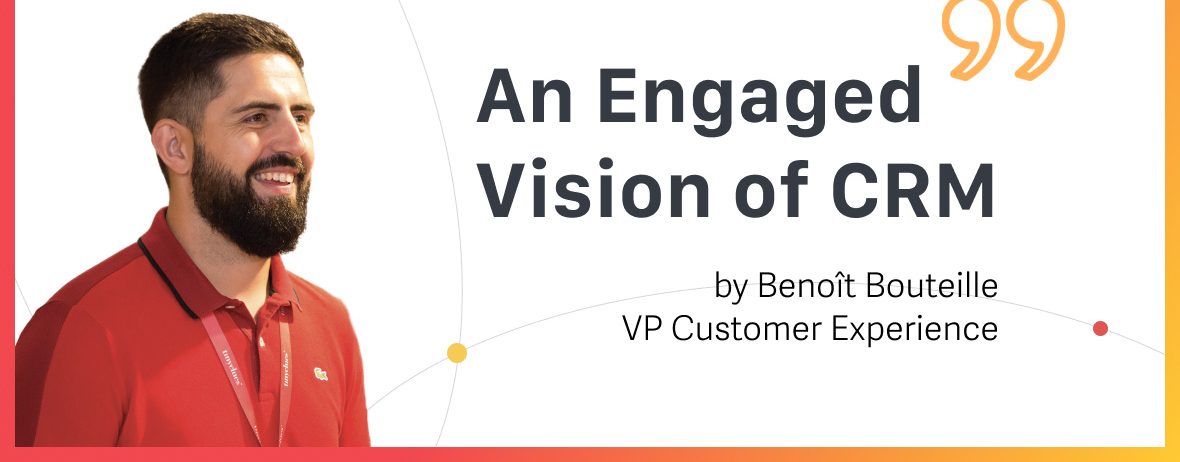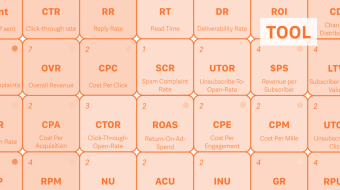Some would lift an eyebrow at this combination of words. Luckily, society is coming to value sustainability, respect, and privacy more and more. Brands that do not adapt will have a hard time staying competitive. The pace of change is only accelerating. The CRM landscape has shifted so much in the past 12 months – and it’s only the beginning. But we can still have some fun trying to make predictions about what all of this change means for our CRM practices… and a good vision should stand the test of time, anyway. So, we asked our very own Ben Bouteille about his take on the evolution of CRM, both recent and future. Read on and get inspired!
The CRM marketing landscape has seen a lot of shifts in the past couple of years.. What do you think are some major changes?
I’d say we’re seeing three types of changes – really, an acceleration of macro trends. For years, there has been a societal movement toward giving more importance to what really matters in life. That’s why topics like ecology, privacy, joy and personal growth, work-life balance, have been on the main stage recently – and it’s only been accelerated by the pandemic.
So what does this mean for us in CRM marketing?
1. More than ever, we have to put our customers first. And obviously that means respecting the desire for privacy, but it also means recognizing that it’s not acceptable anymore, or even constructive, to send messages that do not spark interest.
2. Marketers themselves, of course, are looking for fulfillment in the art of marketing, and there’s really a quest among them for more autonomy, more creativity, more control over their practice. Somewhere along the way, CRM marketers became subject to planning (often dictated by company schedule and objectives) and technology – they spend so much of their time on pure execution, plumbing, data crunching, etc.
Now, luckily, technology has reached a point where it’s no longer a constraint… it’s an enabler. I predict much more autonomy, control and creativity for CRM marketers in the years to come!
3. What’s interesting is that these first two trends are self-fulfilling, and they have driven major changes in the technology landscape. First, Big Tech is responding to consumers’ desire for more privacy. That’s why there were some big announcements recently: Google turning off cookies, Apple essentially disabling email open tracking… And second, the Martech vendor landscape is reshuffling; we’ve seen that with what happened with CDPs, especially – the big disillusionment with so-called CDPs offered by traditional vendors… and the ascent of Google Cloud Platform as a solid alternative for many brands to build an in-house CDP that will give them the freedom to execute their marketing vision without being locked-in into a single vendor’s marketing cloud.
Wow, there’s a lot to unpack there. First off, can you tell us more about the tech changes related to privacy? What’s your advice on how marketers should adapt?
Definitely. The end of cookies is a very interesting topic – it’s actually an opportunity for CRM marketing to regain importance within organizations. Traditionally, the biggest budgets have gone to acquisition, but acquisition – as well as remarketing with 3rd party cookies – is going to get even more arduous and expensive. This might be the nudge that organizations need to focus more on leveraging their customer bases and their first-party data. I do think that companies that realize this in time and adapt will be the big winners next year and beyond. There’s still time to turn the crisis into a massive opportunity!
What about the end of email tracking in iOS15?
At this time, it’s only going to be iOS15 indeed, but who knows whether other players are going to follow suit in the coming months? Marketers really need to think ahead here. I’ve always advocated for looking at business metrics rather than just email engagement metrics, anyway – when you think about it, what does an open really mean? Aren’t most marketers giving them way too much weight, just because they are (they were!) easy to track? So, yes, of course marketers are going to have to adapt, especially if they use engagement-based triggers or segmentations, or attribution models. But it’s for the best: they’ll re-center on the data that really matters. Well, unless they choose to go back batch-&-blast because it’s easier… But that would be a really sad decision. I guarantee they’ll see a drop in customer loyalty and revenue if they do that… and it won’t be an illusion due to a problem with their attribution model! So even if nothing comes free, I believe that marketers will sooner roll up their sleeves to do a better job than go back to bad practices!
You mentioned Google Cloud Platform. Can you tell us a bit more?
Our CEO recently wrote, “Google Cloud could very possibly be the hottest Martech vendor out there”. I love how thought-provoking this sentence is – and yet it’s so true! There’s a real shift happening here, but again, it’s a symptom of marketers’ quest for more autonomy. Choosing GCP – or another headless CDP – means your organization is going to be really agile in terms of how they leverage their first party-data, and you’re going to be able to build the best marketing stack by choosing best-of-breed solutions for each of your needs. And that’s going to be really, really critical if brands are to stay competitive.
Okay, enough tech talk. CRM is about the customer, after all. What do you mean by, “More than ever, we have to put our customers first”?
It’s very simple – for brands, competition for customers’ attention is becoming tougher everyday. So, what may have been good enough in the past is quickly becoming inefficient at best, and counter-productive sometimes. So, even beyond the privacy aspect, which we touched on already – treating customers like an homogeneous mass, sending them generic batch & blast messages, poorly executed triggers that conflict with each other… This just doesn’t cut it anymore.
The most common attempts at segmentation and targeting are becoming too rudimentary.
Think RFM or rule-based segmentation. Every time you, as a marketer, come up with segmentation criteria, you’re only introducing human bias into your communications. You think handbags are for women? That video games are for your gamer segment? Sure, maybe. I don’t know. Actually, I do know that’s wrong. We’ve run so many tests with clients that prove just the opposite. Men buy for themselves or for their loved ones. Gamers do buy games, but so do Grandmas when Christmas is approaching.
Humans are sophisticated creatures, who love spontaneity and serendipity and, generally, will do everything they can get out of the boxes we’d like to stick them in.
Luckily, this last decade’s advances in technology and machine learning have made it possible to predict buying intent and customer interests with astounding accuracy, in much more sophisticated ways than just looking at purchase and browsing history or hand-written segments. And it’s even easy to implement!
What’s in it for CRM marketers?
I predict that this decade will be exhilarating for CRM marketers. First, CRM will regain a lot of attention within organizations, as I mentioned earlier. Bigger budgets, more executive sponsorship… you name it.
Second, CRM marketers have, at last, the opportunity to regain control of their strategy. See, even today, CRM teams often are subjected to demands from the entire organization, and have limited power over the planning. They’re asked to blast more emails if a little revenue boost is needed to make the quarter’s target. They’re asked to promote this product launch, this partner campaign, etc. They’re constantly torn between these demands and their instinct to protect customer-centricity, and there are really not that many satisfactory solutions.
And there’s also a problem with workflow and bandwidth allocations. CRM teams that are fortunate enough to have the help of a data science team for advanced targeting… are subject to the data science team’s bandwidth. There can be no agility there. Or, they have to spend their time doing journey and rule plumbing in complex interfaces that won’t yield good enough results to justify the energy spent. There’s no time for creativity, for the bigger picture, for thinking about innovative ways to progress on the customer-centricity journey.
But today, there’s a new generation of CRM marketing technologies that can help with that. The kind of technology that’s sophisticated enough to be infinitely more customer-centric than previous approaches, while also taking into account all the business demands that are,after all,very legitimate for the most part!… and also – and this is very important – the kind of technology that hides the complexity under the hood, to help marketers regain control over their time, and focus on the fulfilling part of marketing: creativity, strategy, customer-centricity.
A last word?
Everything I’ve said here is in the context of recent shifts in the market, of course, but it’s aligned with the vision of CRM marketing that I’ve always fought for. And it’s actually the reason I joined Tinyclues more than 5 years ago, to help spread this vision and nudge CRM practices in the right direction! So if any of these words strike a chord, please drop me a line; I’d be happy to discuss anything CRM (or baseball!) related and advise you on your journey toward more customer-centricity. Because my team and I, both as professionals and consumers, we won’t stop until you’re not spamming us anymore.




